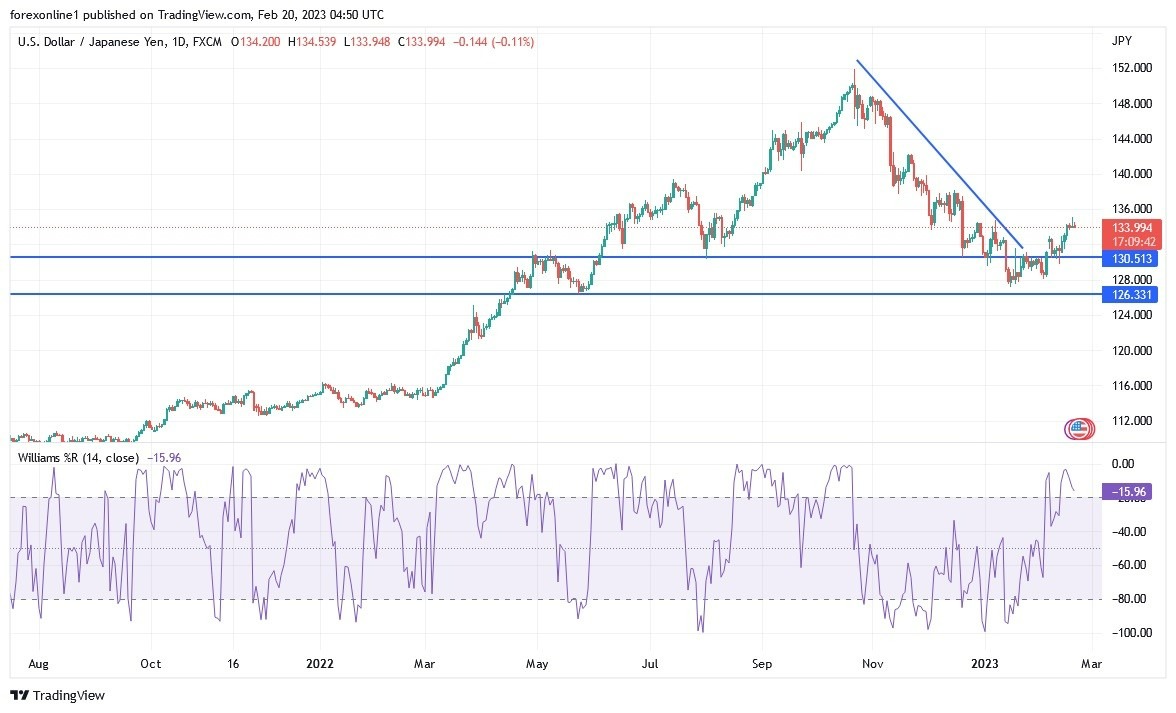[ad_1]
In the near term, and according to the performance on the hourly chart, it appears that the USD/JPY currency pair is trading within a bullish channel formation.
- The clarity of the vision for the future of the Japanese central bank’s policy under new leadership and the increasing positive momentum for the US dollar are due to stronger-than-expected figures for the US economic sectors.
- This supports the path of tightening the US Federal Reserve’s policy in the coming months, contributing to the strong gains of the USD/JPY currency pair.
The yen is a popular asset during turbulent times.
Last week, gains reached the resistance level of 135.10, the highest for the currency pair in two months, and it closed the week’s trading stable around the level of 134.15, on an important date this week, as the markets await the content of the minutes of the last meeting of the US Federal Reserve.
For their part, Wall Street traders have fully priced in quarter-point increases at both of the next Fed meetings – and the eventual higher peak in US interest rates. The index swap contract overnight in May rose to 5.11 percent, more than 50 basis points above the current effective federal funds rate. The market also priced in the so-called final interest rate, with the July contract rising to 5.31 percent, reflecting a nearly 70 percent chance of a third quarter-point hike in June. The moves were accompanied by the recent increase in US Treasury yields to their highest levels of the year, as the two-year bond rose by as much as 7 basis points to 4.71 percent, within 10 basis points of its multi-year highs in November.
Treasury yields erased their early rally and fell 2 to 5 basis points across the curve in late New York trading, with the turnaround reflecting the squaring of an oversold market ahead of the long weekend. The two-year sensitive policy was sharply higher over the week, up from 4.52 percent.
In remarks on Friday, Fed Governor Michelle Bowman said the US central bank should continue to raise interest rates to reduce inflation, which remains “very high.” The upward shift in market expectations of the Fed’s policy path was driven by economic reports showing a tight labor market and inflation that was firmer than the market had expected at the start of the year.
Therefore, on Thursday, economists at Bank of America and Goldman Sachs revised their forecasts for Fed policy to include a rate hike in June to follow up on moves in March and May. Accordingly, Seth Carpenter, chief global economist at Morgan Stanley, told Bloomberg Television that more data showing that the strength in January “wasn’t anomalous” and would increase pressure on the Fed to accelerate its pace. He added that another business report similar to last month would prompt policymakers to consider returning to half-point increases. Two officials indicated last Thursday that they were open to that.
The US Federal Reserve has raised its interest rate eight times since March 2022, most recently in a range of 4.5 percent – 4.75 percent on February 1, after it fell to around 0 percent at the start of the pandemic. The US central bank signaled at the end of last year an expected peak of 5.1 percent for policy and no interest rate cuts in 2023. Traders by swaps covering the December Fed meeting cut the odds of a rate cut by a quarter point from the peak by the end of the year
The Fed’s preferred inflation measures this week, along with a sharp rise in consumer spending, are seen as sparking debate among central bankers about the need to moderate the pace of interest rate increases. The US personal consumption expenditures price index is expected to have increased 0.5% in January from the previous month, the largest advance since mid-2022. The median estimate in a Bloomberg survey of economists expects a 0.4% advance in the core measure, which excludes food and fuel and mostly reflects Better core inflation.
USD/JPY Forecast:
In the near term, and according to the performance on the hourly chart, it appears that the USD/JPY currency pair is trading within a bullish channel formation. This indicates a significant short-term bullish bias in market sentiment. Therefore, the bulls will look to ride the current rally towards 135.593 or higher to the 136.158 resistance. On the other hand, the bears will target potential pullback profits of around 134,296 or below at the 133,710 support.
In the long run, and according to the performance on the daily chart, it appears that the USD/JPY is trading within a bullish channel formation. This indicates a significant long-term bullish bias in market sentiment. Therefore, the bulls will target extended gains at around 137.682 or higher at the 140.192 resistance. On the other hand, the bears – bears – will be looking to pounce on long-term gains at around 132,661 or below at the 130,150 support.

Ready to trade our Forex daily forecast? We’ve shortlisted the best Forex brokers in the industry for you.
[ad_2]